2017 PEUGEOT 4008 fog light
[x] Cancel search: fog lightPage 6 of 368

4
4008_en_Chap00b_vue-ensemble_ed01-2016
exterior
Lighting controls 127-131
Headlamp beam adjustment 1 33
Welcome lighting
1
32
Changing bulbs
1
99-202
-
f
ront lamps
-
f
ront foglamps
-
d
irection indicator repeaters
W iper c ontrols
13
4 -137
Changing a wiper b l a d e
17
6
Door mirrors
7
6 -77
Doors
6
2, 64
-
ope
ning / closing
-
c
entral locking
Child lock
1
71
el
ectric windows
6
8 - 69
Alarm
65-67
Panoramic sunroof
7
0
Roof bars
1
79
Braking assistance
1
43-144
tra
jectory control
1
45-146
ty
re pressures
1
93, 233
un
der-inflation detection
1
14-117
Boot
63
-
ope
ning / closing
-
em
ergency release
te
mporary puncture
repair kit
1
89-192
Changing a wheel
1
93-198
-
tools
-
r
emoving / refitting
Snow chains
1
75
Changing bulbs
2
03-204
-
r
ear lamps
-
3rd brake lamp
-
n
umber plate lamps
-
foglamp
Parking sensors
1
23-125
Reversing camera
1
26
to
w b a r
17 7-178
to
wing
215 -217
Fuel tank
1
73
Remote control key /
electronic key
5
2-61
-
ope
ning / closing
-
a
nti-theft protection
-
battery
Over view
Page 12 of 368

10
4008_en_Chap00c_eco-conduite_ed01-2016
eco-drivingeco-driving is a range of everyday practices that allow the motorist to optimise their fuel consumption and CO2 emissions.
Optimise the use of your gearbox
With a manual gearbox, move off gently and change up without waiting.
During acceleration, change up early.
With an automatic gearbox, give preference to automatic mode and
avoid pressing the accelerator pedal heavily or suddenly.
th
e gear shift indicator invites you to engage the most suitable gear:
as soon as the indication is displayed in the instrument panel, follow it
straight away.
For vehicles fitted with an automatic gearbox, this indicator appears
only in manual mode.
Drive smoothly
Maintain a safe distance between vehicles, use engine braking rather
than the brake pedal, and press the accelerator progressively. th ese
practices contribute towards a reduction in fuel consumption and CO
2
emissions and also help to reduce the background traffic noise.
Control the use of your electrical
equipment
Before moving off, if the passenger compartment is too warm, ventilate it
by opening the windows and air vents before using the air conditioning.
Above 30 mph (50 km/h), close the windows and leave the air vents
open.
Remember to make use of equipment that can help keep the
temperature in the passenger compartment down (sunroof, window
blinds, etc.).
Switch off the air conditioning, unless it has automatic regulation, as
soon as the desired temperature is attained.
Switch off the demisting and defrosting controls, if not automatic.
Switch off the heated seat as soon as possible.
Switch off the headlamps and front foglamps when the level of light
does not require their use.
Avoid running the engine before moving off, particularly in winter; your
vehicle will warm up much faster while driving.
As a passenger, if you avoid connecting your multimedia devices
(film, music, video game, etc.), you will contribute towards limiting the
consumption of electrical energy, and so of fuel.
Disconnect your portable devices before leaving the vehicle.
If your vehicle has cruise control, make use of the system at speeds
above 25 mph (40 km/h) when the traffic is flowing well.
eco-driving
Page 18 of 368

16
Operation indicator lamps
If one of the following indicator lamps comes on, this confirms that the corresponding system has come into operation.
It may be accompanied by an audible signal and a message in the instrument panel screen.Warning /indicator lampis on Cause Action / Observations
Left-hand
direction
indicator flashing with audible
warning.
th
e lighting stalk has been pressed
downwards. If this indicator lamp flashes abnormally quickly, this
could indicate that the bulb of one of the direction
indicators has blown. Change the bulb or contact a
P
e
uge
Ot
dealer or a qualified workshop.
Right-hand
direction
indicator flashing with audible
warning.
th
e lighting stalk has been pushed
upwards. If this indicator lamp flashes abnormally quickly, this
could indicate that the bulb of one of the direction
indicators has blown. Change the bulb or contact a
P
e
uge
Ot
dealer or a qualified workshop.
Sidelamps or
dipped beam
headlamps fixed.
th
e sidelamps or dipped beam
headlamps are on.
Main beam
headlamps fixed.
th
e lighting stalk is pulled towards
you. Pull the stalk to return to dipped beam headlamps.
Front foglamps fixed.
th
e front foglamps are switched on
using the ring on the lighting control
stalk.
tu
rn the ring on the lighting control stalk rear ward
once to switch off the front foglamps.
Rear foglamp sfixed.
th
e rear foglamps are switched on.
tu
rn the ring on the stalk rear ward to switch off the
rear foglamps.
Instruments
Page 129 of 368
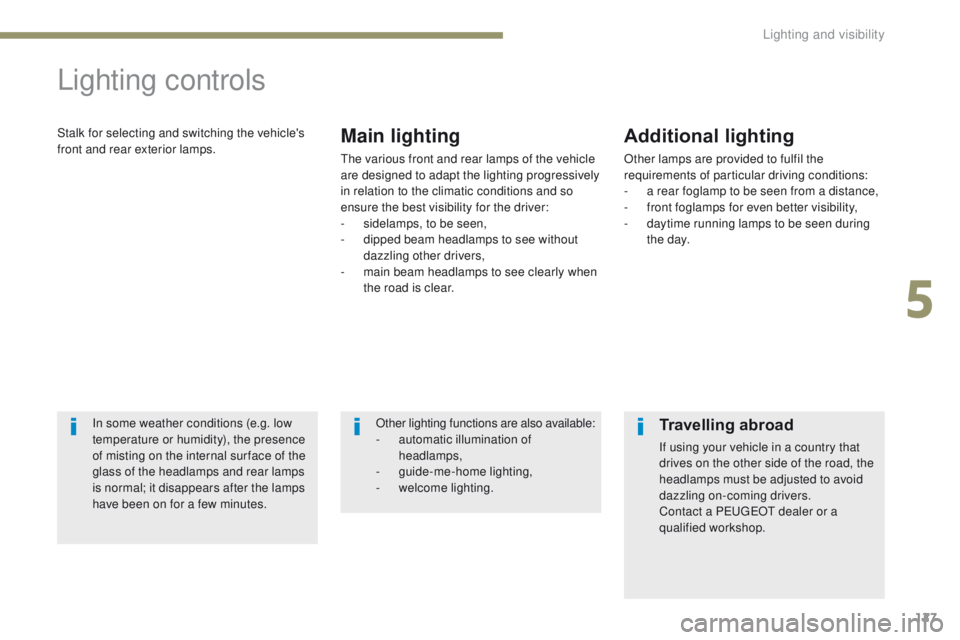
127
4008_en_Chap05_Eclairage-et-visibilite_ed01-2016
Lighting controls
Stalk for selecting and switching the vehicle's
front and rear exterior lamps.Main lighting
the various front and rear lamps of the vehicle
are designed to adapt the lighting progressively
in relation to the climatic conditions and so
ensure the best visibility for the driver:
-
s
idelamps, to be seen,
-
d
ipped beam headlamps to see without
dazzling other drivers,
-
m
ain beam headlamps to see clearly when
the road is clear.
Additional lighting
Other lamps are provided to fulfil the
requirements of particular driving conditions:
-
a r
ear foglamp to be seen from a distance,
-
f
ront foglamps for even better visibility,
-
d
aytime running lamps to be seen during
t h e d ay.
In some weather conditions (e.g. low
temperature or humidity), the presence
of misting on the internal sur face of the
glass of the headlamps and rear lamps
is normal; it disappears after the lamps
have been on for a few minutes. Other lighting functions are also available:
-
a
utomatic illumination of
headlamps,
-
gu
ide-me-home lighting,
-
w
elcome lighting.
Travelling abroad
If using your vehicle in a country that
drives on the other side of the road, the
headlamps must be adjusted to avoid
dazzling on-coming drivers.
Contact a P
e
uge
Ot
dealer or a
qualified workshop.
5
Lighting and visibility
Page 131 of 368
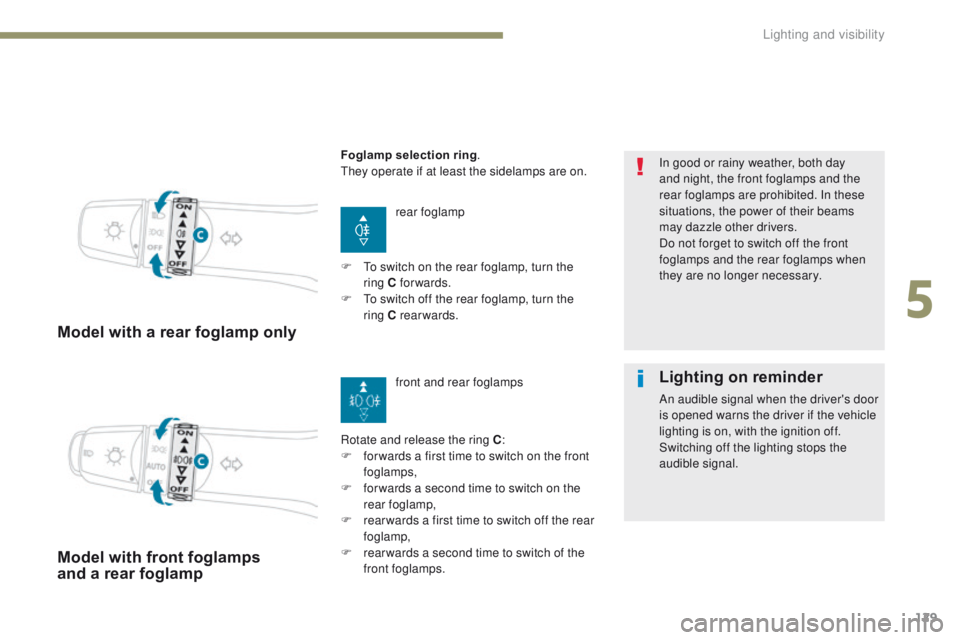
129
4008_en_Chap05_Eclairage-et-visibilite_ed01-2016
Model with a rear foglamp only
rear foglamp
Rotate and release the ring C :
F
f
or wards a first time to switch on the front
foglamps,
F
f
or wards a second time to switch on the
rear foglamp,
F
r
ear wards a first time to switch off the rear
foglamp,
F
r
ear wards a second time to switch of the
front foglamps. In good or rainy weather, both day
and night, the front foglamps and the
rear foglamps are prohibited. In these
situations, the power of their beams
may dazzle other drivers.
Do not forget to switch off the front
foglamps and the rear foglamps when
they are no longer necessary.
Model with front foglamps
and a rear foglamp
Foglamp selection ring
.th
ey operate if at least the sidelamps are on.
F
t
o s
witch on the rear foglamp, turn the
ring C forwards.
F
t
o s
witch off the rear foglamp, turn the
ring C rearwards.
front and rear foglamps
Lighting on reminder
An audible signal when the driver's door
is opened warns the driver if the vehicle
lighting is on, with the ignition off.
Switching off the lighting stops the
audible signal.
5
Lighting and visibility
Page 132 of 368
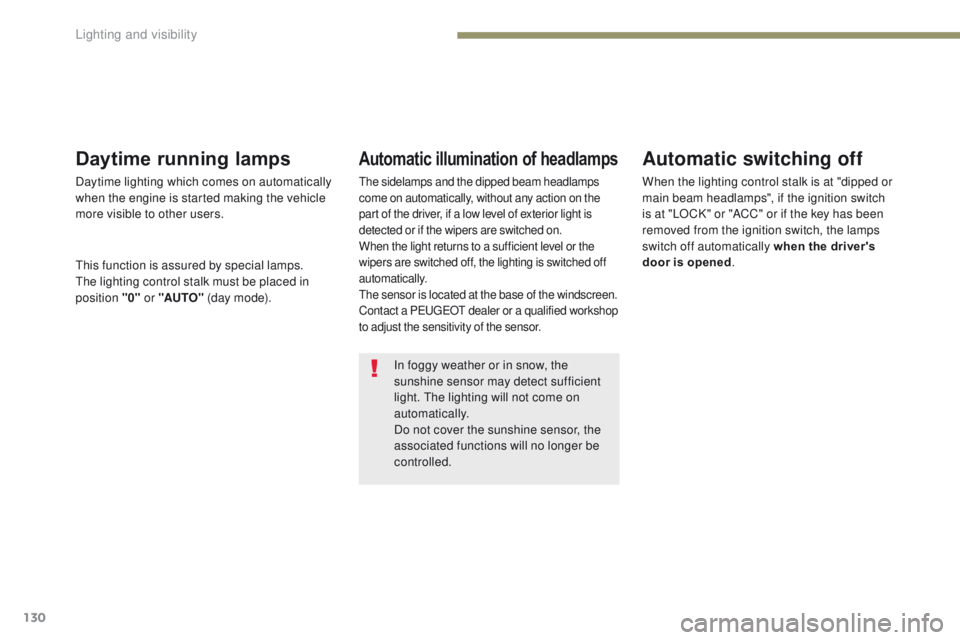
130
4008_en_Chap05_Eclairage-et-visibilite_ed01-2016
In foggy weather or in snow, the
sunshine sensor may detect sufficient
light. t
h
e lighting will not come on
automatically.
Do not cover the sunshine sensor, the
associated functions will no longer be
controlled.
Automatic switching off
When the lighting control stalk is at "dipped or
main beam headlamps", if the ignition switch
is at "LOCK" or "ACC" or if the key has been
removed from the ignition switch, the lamps
switch off automatically when the driver's
door is opened .
Daytime running lamps
Daytime lighting which comes on automatically
when the engine is started making the vehicle
more visible to other users.
th
is function is assured by special lamps.
th
e lighting control stalk must be placed in
position "0" or "AUTO" (d ay m o d e).
Automatic illumination of headlamps
the sidelamps and the dipped beam headlamps
come on automatically, without any action on the
part of the driver, if a low level of exterior light is
detected or if the wipers are switched on.
When the light returns to a sufficient level or the
wipers are switched off, the lighting is switched off
automatically.
th
e sensor is located at the base of the windscreen.
Contact a P
e
uge
Ot
dealer or a qualified workshop
to adjust the sensitivity of the sensor.
Lighting and visibility
Page 201 of 368
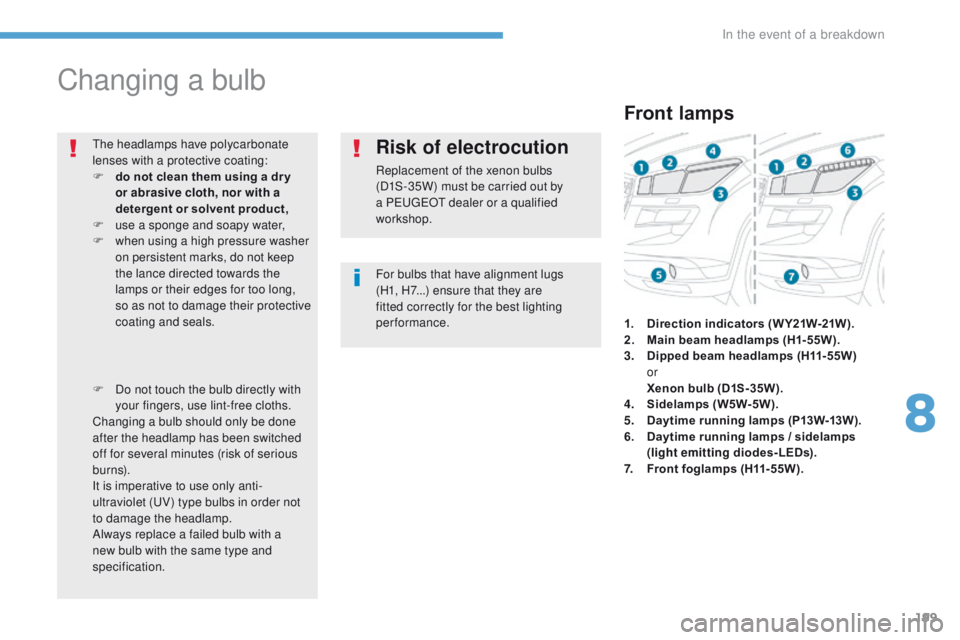
199
4008_en_Chap08_en-cas-de panne_ed01-2016
Changing a bulb
For bulbs that have alignment lugs
(H1, H7...) ensure that they are
fitted correctly for the best lighting
performance.
th
e headlamps have polycarbonate
lenses with a protective coating:
F
d
o not clean them using a dr y
or abrasive cloth, nor with a
detergent or solvent product,
F
u
se a sponge and soapy water,
F
w
hen using a high pressure washer
on persistent marks, do not keep
the lance directed towards the
lamps or their edges for too long,
so as not to damage their protective
coating and seals.
F
D
o not touch the bulb directly with
your fingers, use lint-free cloths.
Changing a bulb should only be done
after the headlamp has been switched
off for several minutes (risk of serious
burns).
It is imperative to use only anti-
ultraviolet (
uV
) type bulbs in order not
to damage the headlamp.
Always replace a failed bulb with a
new bulb with the same type and
specification.
Risk of electrocution
Replacement of the xenon bulbs
(D1S-35W) must be carried out by
a P
e
uge
Ot
dealer or a qualified
workshop.
Front lamps
1. Direction indicators ( W Y21W-21W ).
2. M ain beam headlamps (H1-55W).
3.
D
ipped beam headlamps (H11-55W)
or
Xe
non bulb (D1S-35W).
4.
S
idelamps (W5W-5W).
5.
D
aytime running lamps (P13W-13W).
6.
D
aytime running lamps / sidelamps
(light emitting diodes-LEDs).
7.
F
ront foglamps (H11-55W).
8
In the event of a breakdown
Page 203 of 368
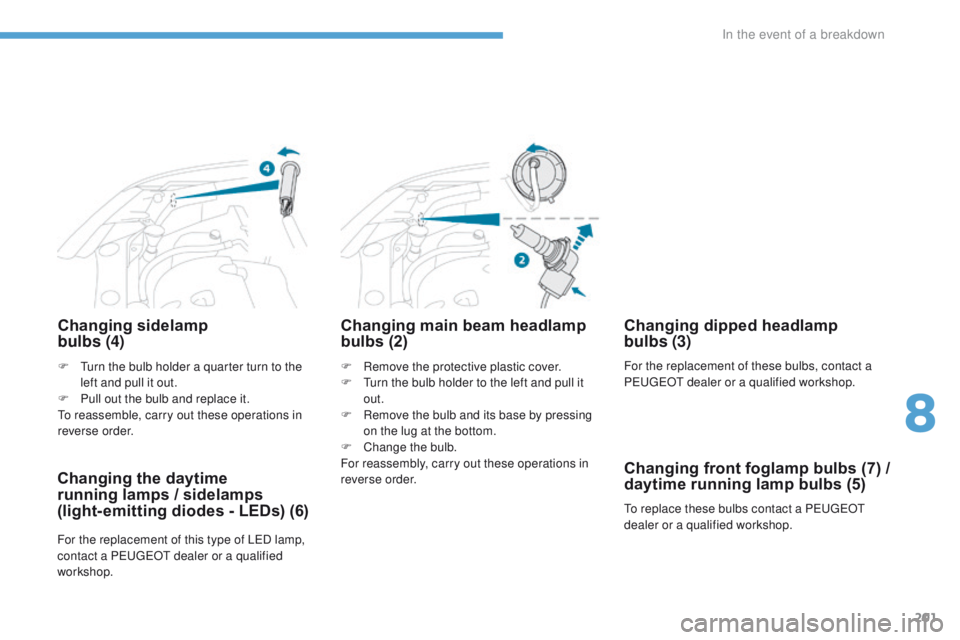
201
4008_en_Chap08_en-cas-de panne_ed01-2016
Changing sidelamp
bulbs (4)
F Remove the protective plastic cover.
F
tu rn the bulb holder to the left and pull it
out.
F
R
emove the bulb and its base by pressing
on the lug at the bottom.
F
C
hange the bulb.
For reassembly, carry out these operations in
reverse order.
Changing main beam headlamp
bulbs (2)
F turn the bulb holder a quarter turn to the left and pull it out.
F
P
ull out the bulb and replace it.
to r
eassemble, carry out these operations in
reverse order.
Changing the daytime
running lamps / sidelamps
(light- emitting diodes - LEDs) (6)
For the replacement of this type of LeD l amp,
contact a Pe ugeOt dealer or a qualified
workshop.
Changing dipped headlamp
bulbs (3)
For the replacement of these bulbs, contact a
Pe ugeOt dealer or a qualified workshop.
to r
eplace these bulbs contact a P
e
uge
Ot
dealer or a qualified workshop.
Changing front foglamp bulbs (7) /
daytime running lamp bulbs (5)
8
In the event of a breakdown